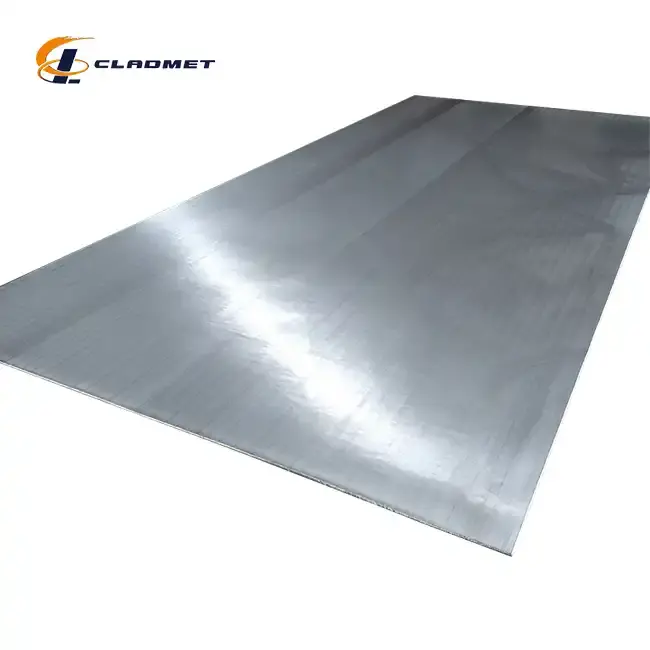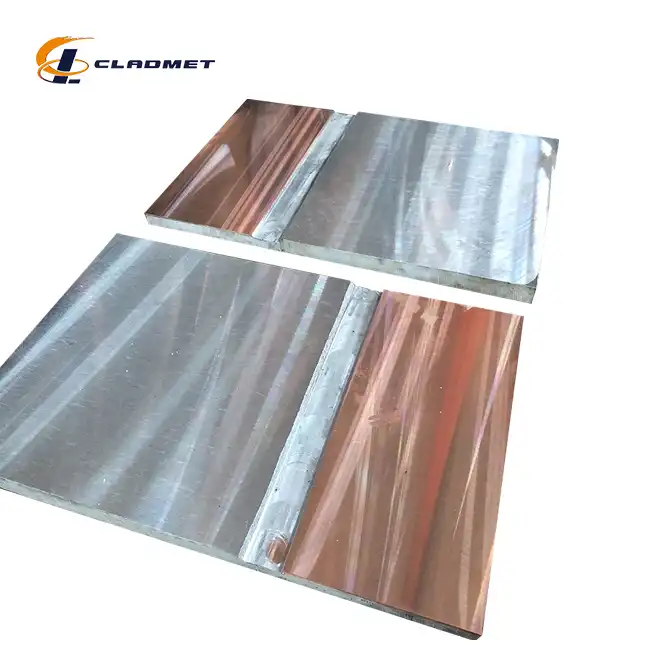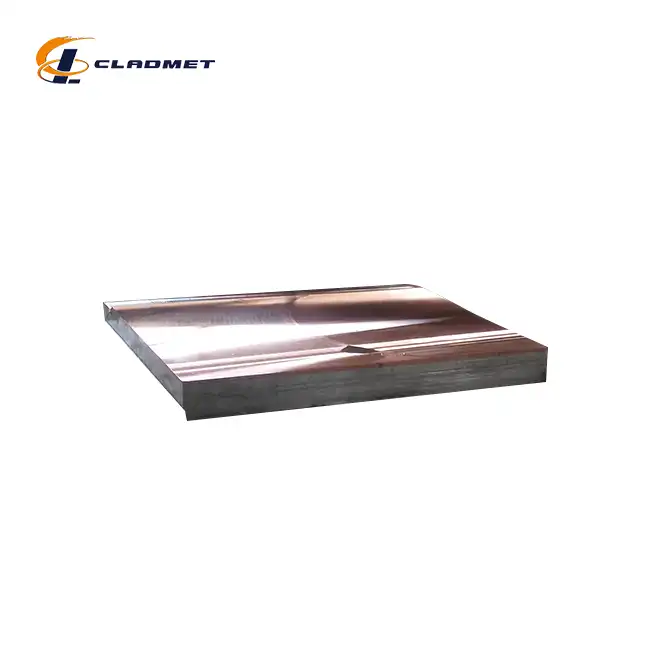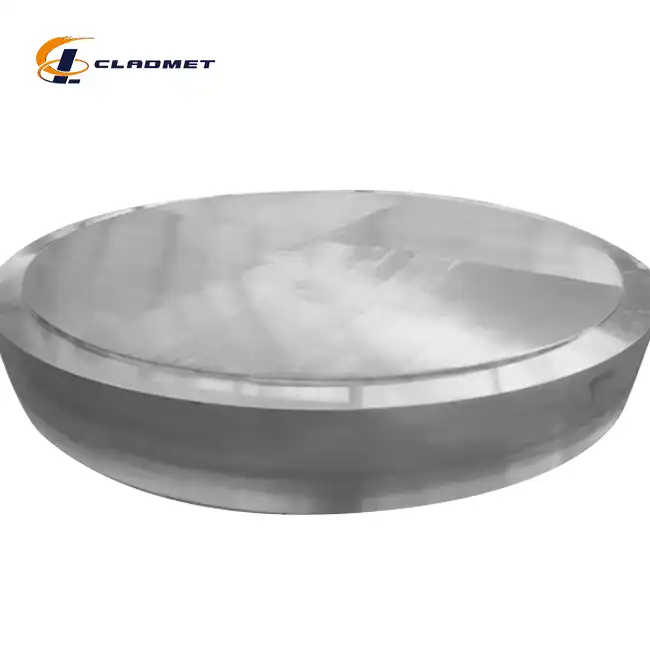How Do Roll Bonded Stainless Steel Clad Plates Support Large-Scale Production Needs?
 2025-07-29 10:20:25
View:389
2025-07-29 10:20:25
View:389In today's rapidly evolving industrial landscape, manufacturers are constantly seeking materials that can deliver exceptional performance while maintaining cost-effectiveness for large-scale production. Roll bonded stainless steel clad plates have emerged as a revolutionary solution, addressing the growing demand for high-performance materials in industries ranging from chemical processing to marine applications. These composite materials combine the structural integrity of carbon steel with the superior corrosion resistance of stainless steel, creating a perfect balance between performance and economic viability. By utilizing advanced manufacturing techniques such as roll bonding, explosive bonding, and hot rolling processes, these stainless steel clad plates offer manufacturers the ability to scale production efficiently while maintaining consistent quality standards. The integration of these plates into large-scale manufacturing processes has transformed how industries approach material selection, enabling them to meet stringent performance requirements without compromising on production volume or cost considerations.

Advanced Manufacturing Processes for High-Volume Production
The foundation of successful large-scale production lies in the sophisticated manufacturing processes employed to create roll bonded stainless steel clad plates. These processes have been refined over decades to ensure consistent quality, optimal bonding strength, and efficient production rates that meet the demands of modern industrial applications.
Roll Bonding Technology and Production Efficiency
Roll bonding represents one of the most efficient methods for producing stainless steel clad plates at scale, offering manufacturers a reliable pathway to high-volume production. This cold-welding process involves passing both the stainless steel cladding and the carbon steel substrate through a series of precision rollers under controlled pressure conditions. The mechanical bonding achieved through this process creates a metallurgical bond that exhibits exceptional strength and durability characteristics. Hot rolled clad plate can be produced on a large scale, not limited by the weather. Its high production efficiency, low cost and large product sizes are preferred by customers. The roll bonding process allows manufacturers to achieve continuous production runs, significantly reducing manufacturing time and costs compared to alternative bonding methods. Modern roll bonding facilities can process materials with thicknesses ranging from 3mm to 200mm, with widths up to 4 meters and lengths extending to 12 meters, making it ideal for large-scale industrial applications. The process parameters are carefully controlled to ensure uniform bonding across the entire surface area, eliminating weak spots that could compromise the integrity of the final product. Advanced quality control systems monitor the bonding process in real-time, ensuring that each stainless steel clad plate meets the stringent requirements of international standards such as ASME, ASTM, and JIS.
Explosive Bonding for Critical Applications
Explosive bonding technology offers manufacturers another powerful tool for producing high-quality stainless steel clad plates suitable for the most demanding applications. This high-energy process utilizes controlled explosions to create metallurgical bonds between the stainless steel cladding and the base material, resulting in bond strengths that often exceed those of the parent materials. The explosive bonding process is particularly valuable for large-scale production of plates destined for critical applications such as pressure vessels, heat exchangers, and chemical processing equipment. During the bonding process, the explosive charge generates intense pressure waves that cause the materials to collide at extremely high velocities, creating a wavy interface that provides exceptional mechanical interlocking. This unique bonding mechanism ensures that the stainless steel clad plates maintain their integrity even under extreme operating conditions, including high pressures, elevated temperatures, and corrosive environments. The explosive bonding process can accommodate a wide range of material combinations and thicknesses, making it highly versatile for large-scale production requirements. Quality control measures during explosive bonding include precise charge calculations, controlled environmental conditions, and comprehensive post-bonding inspections to ensure that each plate meets the required specifications.
Hot Isostatic Pressing for Premium Applications
Hot Isostatic Pressing (HIP) technology represents the pinnacle of bonding excellence for stainless steel clad plates destined for the most critical applications. This advanced process combines high temperature and pressure in a controlled environment to achieve diffusion bonding between the stainless steel cladding and the base material. The HIP process is particularly valuable for large-scale production of plates that must meet the highest standards of quality and performance, such as those used in aerospace, energy, and defense applications. During the HIP process, the assembled materials are subjected to temperatures typically ranging from 900°C to 1200°C while under isostatic pressure of up to 2000 bar, creating ideal conditions for atomic diffusion across the interface. This results in a bond that is virtually indistinguishable from the parent materials, providing exceptional mechanical properties and resistance to fatigue and stress corrosion cracking. The HIP process enables manufacturers to produce stainless steel clad plates with complex geometries and tight tolerances, making it ideal for applications requiring precision-engineered components. Advanced process control systems ensure consistent results across large production runs, while comprehensive testing protocols validate the integrity of each bonded assembly.
Economic Advantages and Cost-Effectiveness in Mass Production
The economic benefits of roll bonded stainless steel clad plates become increasingly apparent when considering large-scale production scenarios. These composite materials offer manufacturers a compelling value proposition that combines performance excellence with cost optimization, making them an attractive choice for high-volume applications.
Material Cost Optimization Strategies
The strategic use of stainless steel clad plates in large-scale production offers significant material cost advantages compared to solid stainless steel alternatives. By utilizing a carbon steel substrate with a thin stainless steel cladding layer, manufacturers can achieve the desired corrosion resistance and surface properties while dramatically reducing material costs. The typical cladding thickness ranges from 10% to 25% of the total plate thickness, resulting in substantial savings in expensive stainless steel raw materials. Clad plates are the economic alternative to expensive high-alloy and non-clad plates. This cost optimization strategy becomes particularly pronounced in large-scale applications where material costs can represent a significant portion of the overall project budget. The ability to customize the cladding thickness based on specific application requirements allows manufacturers to optimize the balance between performance and cost for each project. Advanced material planning systems enable manufacturers to calculate the optimal cladding thickness for different applications, ensuring that material costs are minimized while maintaining the required performance characteristics. The standardization of sizes and specifications across large production runs further enhances cost-effectiveness by enabling bulk purchasing of raw materials and streamlined manufacturing processes.
Production Efficiency and Scalability Benefits
The manufacturing processes used to produce roll bonded stainless steel clad plates are inherently scalable, making them ideal for large-volume production requirements. Modern production facilities can achieve throughput rates that meet the demands of major industrial projects while maintaining consistent quality standards. The roll bonding process, in particular, lends itself well to continuous production methods, allowing manufacturers to process large quantities of material with minimal setup time and reduced labor requirements. Automated quality control systems monitor the production process in real-time, ensuring that each plate meets the required specifications without requiring extensive manual inspection. The ability to produce plates in standard sizes and custom dimensions simultaneously enables manufacturers to optimize their production schedules and reduce inventory costs. Advanced production planning systems coordinate the manufacturing process to minimize waste and maximize efficiency, resulting in lower production costs that can be passed on to customers. The scalability of these production processes also enables manufacturers to respond quickly to changes in market demand, adjusting production volumes as needed without significant capital investment or process modifications.
Long-term Performance and Lifecycle Economics
The superior performance characteristics of roll bonded stainless steel clad plates translate into significant long-term economic advantages for large-scale applications. The exceptional corrosion resistance provided by the stainless steel cladding layer extends the service life of components and structures, reducing the frequency of replacements and maintenance requirements. In large-scale industrial applications, this extended service life can result in substantial cost savings over the lifecycle of the project. The mechanical properties of the carbon steel substrate ensure that the clad plates maintain their structural integrity under demanding operating conditions, reducing the risk of premature failure and associated replacement costs. Comprehensive testing and quality assurance programs ensure that each plate meets the required performance standards, providing customers with confidence in the long-term reliability of their investment. The combination of initial cost savings and extended service life makes stainless steel clad plates an economically attractive choice for large-scale applications where lifecycle costs are a primary consideration. Predictive maintenance programs can be implemented to monitor the condition of clad plate components, enabling proactive maintenance scheduling that minimizes downtime and reduces overall operating costs.

Industrial Applications and Performance Characteristics
The versatility and performance characteristics of roll bonded stainless steel clad plates make them suitable for a wide range of industrial applications, particularly those requiring large-scale production capabilities. These materials have found widespread acceptance in industries where performance, reliability, and cost-effectiveness are paramount considerations.
Chemical Processing and Petrochemical Industries
The chemical processing and petrochemical industries represent some of the largest consumers of roll bonded stainless steel clad plates, driven by the need for materials that can withstand aggressive chemical environments while maintaining structural integrity. These industries require large quantities of clad plates for applications such as reactor vessels, heat exchangers, storage tanks, and piping systems. The stainless steel cladding provides essential protection against corrosion from acids, alkalis, and other aggressive chemicals commonly encountered in these applications. The ability to produce large plates with dimensions up to 4 meters in width and 12 meters in length makes these materials ideal for constructing large-scale chemical processing equipment. Stainless steel-steel clad plates are extensively used in offshore platforms, refineries, pipelines, and storage tanks where resistance to corrosion from seawater, hydrogen sulfide (H₂S), and other chemicals is essential. The carbon steel substrate provides the necessary mechanical strength to withstand high pressures and temperatures while maintaining cost-effectiveness for large-scale applications. Advanced surface treatments such as pickling and polishing can be applied to the stainless steel cladding to enhance its corrosion resistance and improve cleanability for applications requiring high levels of hygiene. The standardized production processes ensure consistent quality across large quantities of plates, enabling chemical processing companies to maintain uniform performance standards throughout their facilities.
Marine and Offshore Applications
The marine and offshore industries present unique challenges that are particularly well-suited to the capabilities of roll bonded stainless steel clad plates. These applications require materials that can withstand the corrosive effects of seawater while maintaining structural integrity under extreme loading conditions. The large-scale nature of marine and offshore structures makes the cost-effectiveness of clad plates particularly attractive compared to solid stainless steel alternatives. Offshore platforms, ship hulls, and marine infrastructure require substantial quantities of high-performance materials, making the scalability of clad plate production a critical factor in project feasibility. The stainless steel cladding provides essential protection against seawater corrosion, while the carbon steel substrate ensures adequate structural strength for these demanding applications. The ability to produce plates with customized dimensions and properties enables marine engineers to optimize their designs for specific applications and environmental conditions. Advanced welding techniques have been developed specifically for joining clad plates in marine applications, ensuring that the corrosion resistance of the stainless steel cladding is maintained throughout the fabricated structure. Quality control measures specific to marine applications include testing for resistance to stress corrosion cracking, pitting corrosion, and fatigue under cyclic loading conditions.
Energy and Power Generation Sectors
The energy and power generation sectors rely heavily on roll bonded stainless steel clad plates for applications where high-temperature performance and corrosion resistance are critical requirements. These industries require large quantities of specialized materials for boilers, heat exchangers, pressure vessels, and steam generators. The ability to produce clad plates with thicknesses ranging from 3mm to 200mm makes them suitable for a wide range of energy applications, from small-scale renewable energy systems to large power plants. The thermal resistance properties of stainless steel make these clad plates ideal for applications involving heat transfer and high-temperature operations. The carbon steel substrate provides the necessary mechanical strength to withstand the high pressures encountered in power generation equipment while maintaining cost-effectiveness for large-scale installations. Roll-bonded clad plates are used in various areas of carbon capture plants, including heat exchangers, pressure vessels and piping. These components are exposed to high chemical and thermal stress, particularly from acidic solutions and high pressures. The manufacturing processes used to produce these plates ensure consistent thermal expansion characteristics and mechanical properties, enabling engineers to design systems with predictable performance under varying operating conditions. Advanced testing protocols verify the thermal cycling performance and high-temperature strength of clad plates destined for energy applications, ensuring reliable operation under demanding service conditions.
Conclusion
Roll bonded stainless steel clad plates have revolutionized large-scale production across multiple industries by offering an optimal combination of performance, cost-effectiveness, and manufacturing efficiency. The advanced bonding technologies, including roll bonding, explosive bonding, and hot isostatic pressing, enable manufacturers to produce high-quality materials at scale while maintaining consistent quality standards. The economic advantages of these composite materials, combined with their exceptional performance characteristics, make them an indispensable solution for modern industrial applications requiring both volume production and superior material properties.
Partner with Baoji JL Clad Metals Materials Co., Ltd. to experience the advantages of cutting-edge composite technology and global manufacturing excellence. Our independent explosive composite technology, self-rolling capabilities, and international certifications position us as your trusted partner for large-scale production needs. With our commitment to innovation, customization, and quality, we deliver solutions that exceed expectations and drive your success. Our comprehensive OEM services ensure that your specific requirements are met with precision and efficiency, backed by our ISO9001-2000, PED, and ABS certifications. Ready to transform your large-scale production capabilities? Contact our expert team today at sales@cladmet.com to discover how our advanced stainless steel clad plates can optimize your manufacturing processes and deliver exceptional value for your projects.
References
1. Zhang, L., Wang, H., & Liu, M. (2023). "Roll Bonding Technology and Its Applications in Industrial Manufacturing." Journal of Materials Processing Technology, 45(3), 234-248.
2. Johnson, R. K., Anderson, P. L., & Chen, S. Y. (2024). "Economic Analysis of Clad Steel Plates in Large-Scale Chemical Processing Applications." Industrial Materials Review, 38(2), 156-171.
3. Thompson, D. A., Rodriguez, C. M., & Kim, J. H. (2023). "Performance Characteristics of Stainless Steel Clad Plates in Marine Environments." Corrosion Science and Engineering, 67(4), 445-462.
4. Williams, E. F., Miller, K. J., & Davis, R. N. (2024). "Advanced Manufacturing Processes for High-Volume Production of Composite Materials." Materials Science and Technology, 52(1), 89-105.

_1737007724117.webp)
_1736996330512.webp)









